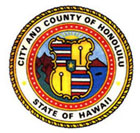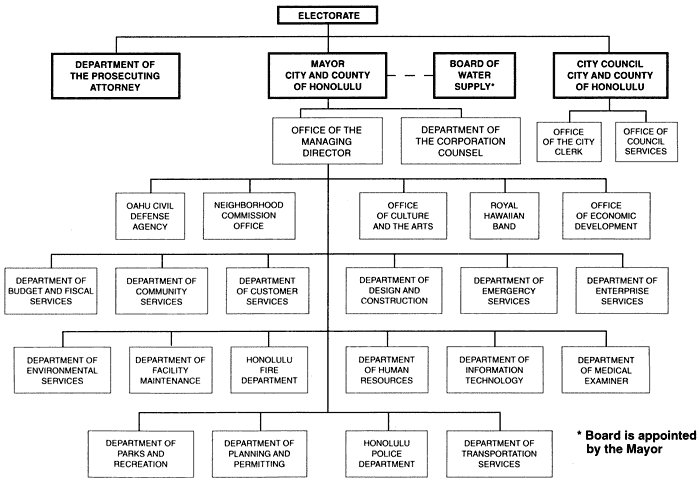Honolulu City Council
|
|
The Honolulu City Council is the legislative branch of the City & County of Honolulu and is considered the second most powerful parliamentary body in the State of Hawai'i, following the Hawai'i State Legislature. Charged with writing and passing laws for the island of O'ahu, the Honolulu City Council meets in chambers at Honolulu Hale year-round.
The Honolulu City Council is composed of nine members from nine administrative districts. Each member is elected to no more than two four-year terms or four two-year terms, depending on the election schedule of the respective districts. Elections are held every other September and are by law, nonpartisan in nature.
| Contents |
Honolulu Hale
The Honolulu City Council conducts official business from Honolulu Hale, a historic city hall building constructed in classical Spanish villa architectural styles and sits along King Street and Punchbowl Boulevard in downtown Honolulu. Other officers under the Honolulu City Council work from separate municipal buildings on the larger civic campus of which Honolulu Hale is a part.
Surrounding Honolulu Hale are other prominent historic landmarks: Ali'iolani Hale, Hawai'i State Capitol, Iolani Palace, Kawaiaha'o Church and theTerritorial Building. Within walking distance are Cathedral of Our Lady of Peace, St. Andrew's Cathedral and Washington Place.
Command Structure
In the line of command for the City & County of Honolulu, the Honolulu City Council balances the power of the Mayor of Honolulu and the Prosecuting Attorney of Honolulu. The Honolulu City Council is reponsible for the confirmation of the heads of the various departments under the mayor's office. Within the sphere of control of the Honolulu City Council are three bodies: Office of the City Clerk, Office of Council Services and the semi-autonomous Office of the City Auditor.
Within the Honolulu City Council, there are three main leadership positions. The officers of the Honolulu City Council are the Chairman, Vice Chairman and the Floor Leader. In the early 2000s, leadership was highly volatile and often controversially stripped, shuffled and changed.
Functions and Duties
Honolulumayorspendingplans.jpg
The Honolulu City Council has identified eleven major functions and duties that are of utmost priority while in session. They are:
- To set city-wide policies by enacting ordinances and adopting resolutions relating to municipal government programs and services such as police and fire protection, parks and recreation, affordable and special needs housing, sanitation and waste disposal, public transportation and other city government operations.
- To initiate new municipal programs which the City may pursue or improve, update and refine existing programs and services.
- To adopt an annual operating and capital programs budget to fund the operations and delivery of city services.
- To adopt measures that will yield sufficient money to balance the budget including the setting of the annual real property tax rate.
- To adopt a general plan and create land use laws establishing and amending the city's development plans and zoning regulations and processes.
- To determine the necessity of taking property for public purposes and authorize condemnation proceedings.
- To confirm city department heads, board and commission members nominated and appointed by the Mayor of Honolulu.
- To fix fees and charges for all city services and the use of city property.
- To authorize settlement of claims filed against the city and against its officers and employees acting within the course of their duties.
- To establish fines and penalties for violations of city ordinances and laws.
- To accept gifts and donations to and on behalf of the city of money, securities or other personal property, or real estate or interests in real estate.
Administrative Districts
For administrative purposes of the Honolulu City Council, the island of O'ahu is divided into nine districts each represented at Honolulu Hale by a popularly elected member. Each district is composed of unincorporated subdivisions unofficially called towns and cities.
- DISTRICT I: ‘Ewa, ‘Ewa Beach, Honouliuli, West Loch, Kapolei, Kalaeloa, Honokai Hale and Nanakai Gardens, Ko‘Olina, Nānākuli, Wai‘anae, Makaha, Kea‘au, Makua.
- DISTRICT II: Mililani Mauka, Wahiawa, Whitmore Village, Mokuleia, Waialua, Haleiwa, Waimea, Pupukea, Sunset Beach, Kahuku, Laie, Hauula, Punaluu, Kahana, Kaaawa, Kualoa, Waiahole, Kahaluu, Ahuimanu, Heeia.
- DISTRICT III: Waimanalo, Kailua, Kaneohe.
- DISTRICT IV: Hawaii Kai, Kuliouou, Niu Valley, Aina Haina, Wailupe, Waialae-Iki, Kalani Valley, Kahala, Wilhemina Rise, a portion of Kapahulu, a portion of Kaimuki, Diamond Head, Waikiki, Ala Moana.
- DISTRICT V: Kapahulu, Kaimuki, Palolo Valley, St. Louis Heights, Manoa, Moiliili, Mc Cully, Kakaako, Ala Moana, Makiki.
- DISTRICT VI: Makiki, downtown Honolulu, Punchbowl, Liliha, Pauoa Valley, Nuuanu, Alewa Heights, Papakolea, Kalihi Valley, Kalihi.
- DISTRICT VII: Kalihi, Kapalama, Palama, Iwilei, Sand Island, Mapunapuna, Airport, Hickam, Pearl Harbor, Ford Island, Aliamanu, Salt Lake, Foster Village, Stadium, Halawa Valley Estates.
- DISTRICT VIII: Fort Shafter, Moanalua, Halawa, Aiea, Pearl City, Pearl City, Seaview, Crestview, Waipio Gentry.
- DISTRICT IX: Waikele, Waipahu, Village Park, Makakilo, Kunia, Mililani.
Resources
- City & County of Honolulu (http://www.co.honolulu.hi.us/)
- Honolulu City Council (http://www.co.honolulu.hi.us/council/index.htm)



